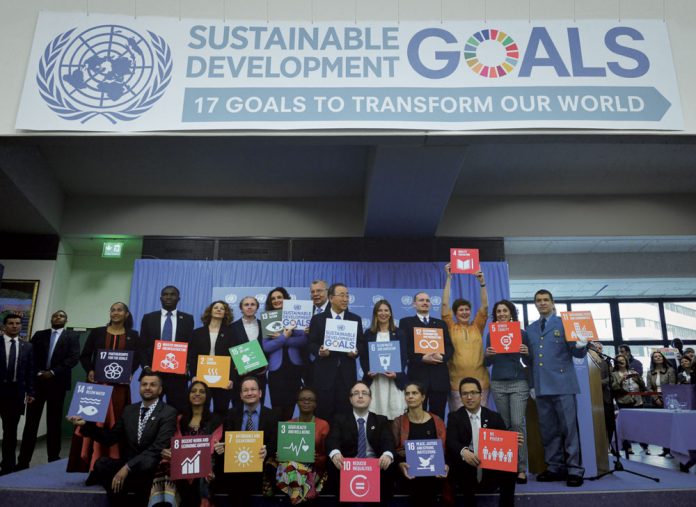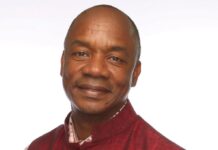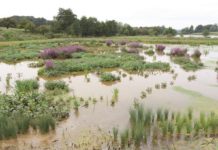UN agencies have engaged in a high-stakes effort to measure the global goals and targets for water and sanitation against clearly defined criteria. Beneath a polite veneer, these ‘UN-Water family’ members are jockeying for scarce funds and struggling to coordinate efforts towards uniform metrics that won’t water down the results
By James Workman
On the 2nd of August 2015, UN member states unanimously adopted 17 goals and 169 targets for Transforming our World: The 2030 Agenda for Sustainable Development. The vote marked an end to the gruelling threeyear process through which hundreds of groups boiled down thousands of discussions into one water and sanitation goal.
The ambition is to mitigate urban water challenges, ensure access to basic services, treat wastewater, and mitigate the impact of water-related disasters in cities, says Gérard Payen of Aquafed, who believes SDG6 “will create a revolution in the water world”. (See box for the full description of SDG6).
It may indeed. But it has also stirred up quiet backroom power struggles. For SDG6 raises questions about how to measure progress in water and sanitation: Which agencies get to monitor states? Where will funds come from, or flow to? What are the water SDG’s metrics of success, or failure?
In short: Who keeps score?
Technicalities matter
Rough answers have begun taking shape. In March 2016, experts proposed a list of indicators for the ‘High-Level Political Forum’ to endorse in July [see box]. The next month the UN Secretary-General Ban Ki-moon named a High-Level Panel on Water. Observers said the “remaining discussions are technical, between water specialists and statisticians”.
Those details, of course, are often where the devil resides. The water scarcity indicator, for example, has been “precisely defined” as “the percentage of total available water resources used, taking environmental water requirements into account (level of water stress).” Left unclear is who calculates how much is “available,” and which indicators define “environmental requirements” since dozens of competing scientific methodologies could yield as many answers. Meanwhile, the indicator for water efficiency remains a blank slate, open to interpretation.
How states count will add up globally. For drinking water, altering one indicator means that the targeted population quadruples from 0.6 billion to +2.5 billion people worldwide. And the implications of this shift matter nationally even locally. Member states could surpass or fall short of water and sanitation targets based on forces outside their control.
Success will be measured in physical changes, such as the extent of durable taps, equitable toilets, resilient tributaries, or efficient treatment plants secured by 2030. But those targets hinge on which performance metrics get established right now.
“If the agency that controls monitoring determines the water SDG performance indicators, a lot could be at stake,” warns Erin R. Graham, a politics professor at Drexel University. She has documented how resource-constrained UN agencies, like a dysfunctional family, routinely compete against each other (as well as with organisations outside the UN) for prestige, jurisdiction and funds.
Some regulators see water SDGs as a powerful tool that can help countries compare against each other using common metrics. Managers can discover asymmetries, address problems, and monitor progress. But success may also require customising general goals to specific needs.
“Performance indicators are only relevant if they are fit for purpose, and support decision-making,” cautions Helena Alegre from the Urban Water Division of Portugal’s National Civil Engineering Laboratory. She urges water professionals to “consider fine tuning some definitions, segmenting the target population or area, or complementing the SDG indicators with others when necessary in order to take the best of this opportunity for their own cases”.
Dysfunctional family
To score the water targets, Graham highlights two factors in tension. First, UN agencies push for narrow and specific performance indicators aligned to their own expertise, which improves the odds “that projects suited to their agency will be prioritised, and increases their access to any funds”. At the same time, she says, donors demand broad indicators that are easily measured and quantified, which all too often means “performance indicators tend to be associated with outputs rather than impact”.

Despite the stakes behind these questions, relatively few outsiders have a say in the answers. Compared with the boisterous, transparent, sprawling fights that shaped the water SDG goals, debate over measuring their progress has been comparatively calm, opaque, and contained.
Veteran insiders compare the merits and compatibility of an obscure alphabet soup of tools–JMP vs GEMI vs GLAAS [see box]–in small group discussions from New York to Geneva to Nairobi and Rome, with far less, if any, participation from non-experts.
Outwardly, the process seems subdued. The “UN-Water family” claims its core monitoring indicators are “based on an extensive consultation process including all UN agencies involved in global monitoring of water and sanitation, academia, business, civil society and Member States.”
Others see a struggle among the 26 UN agencies that deal with water. These large established bureaucracies “already answer to too many masters,” says Graham. Facing a grow-or-die imperative, each has a vested financial interest in seeking to grade water targets, by its own preferred metrics, using its own tool kit.
“In theory having one agency with exclusive authority to coordinate work across dozens of agencies and track progress on the SDGs makes sense,” she adds. “In practice, it is unlikely that the de jure authority of UN Water would translate into de facto authority. If UN-Water controls a lot of money, they can more effectively facilitate coordination. If not, it is likely to be an uphill battle.”
That uphill battle continues to play out behind the scenes, in meetings or coffee breaks. Power coalitions form, or end, based on how and who gets to score water performance.
On 15-16 March 2016, the global partnership entity, Sanitation and Water for All (SWA), organised a Ministerial Conference in Addis Ababa, Ethiopia. The goal was to “improve accountability and work towards a common vision of universal access to safe water and adequate sanitation”. But some observers have suggested it was “about positioning SWA as a lead for monitoring activities”.

Similar jostling is taking place on the other water targets. The World Health Organisation/UNICEF coalition backs JMP, for example, and has been preparing to take water quality issues on board in their global monitoring.
It is a decidedly political process. Graham Alabaster, Chief of Section at UN-Habitat, has been pushing for the GEMI (the initiative focused on monitoring SDG6 targets 6.3-6.6) model but colleagues said he faced fierce resistance.
“As UN agencies we need to do a much better job of responding to the demands of member states and currently much more engagement is required,” says Alabaster. “Global monitoring is built from national monitoring, and national monitoring is driven by a country’s desire to make investment and other decisions.”
Trickle down effects
While such struggles may seem obscure and arcane to the average water professional, the outcome may impact budgets, priorities, careers, and sense of purpose.
The fourteen water targets will impact all national policies, says Payen, and all countries will have to measure progress based on outcomes, rather than simply inputs. That’s why the relative silence on the metrics of these outcomes is puzzling to some.
This is not only a complex issue but also a sensitive one. For example, failure to use GEMI, where it had been in place before, could mean that many countries will suddenly see a considerable reduction in their coverage levels for safe water supply, something that would not be received well by countries that have been judged to be successful under the Millennium Development Goals monitoring.
Crashing the exclusive global club For now, big decisions are emerging from a global elite. Ultimate responsibility for an indicator framework goes to the member state-led Inter-agency and Expert Group on Sustainable Development Goal Indicators (IAEG-SDGs).
Plans to “identify and apply specific, measurable and action-oriented indicators” for the water SDG lean towards buttoned-down order.
Yet exclusivity limits data and reduces peer review. Accurate scientific data, said UN Deputy Secretary-General Jan Eliasson, provide the “lifeblood of decision-making and the raw material for accountability.” This process needs deeply rooted stakeholders to collect vital information.
The SDGs call for a shift from global monitoring to selfmonitoring by national governments. UN agencies lack top-down capacity to monitor on their own, while member states could cherry pick data to show their progress in a favourable light. Aside from potential conflicts of interest, it remains unclear who will pay for the massive capacity building and operational costs such a shift would entail.
Measuring progress is expensive, and member states will have to foot the bill. “Working in ivory towers many UN bureaucrats don’t appreciate the implications of complex and expensive indicator frameworks which divert already scarce resources,” said Alabaster. “I believe we as UN agencies, should be more receptive to the country needs, rather than promoting monitoring approaches which are prescriptive and therefore unacceptable to thrust these ideas to countries without their full engagement. After all, monitoring will cost money and it’s more about nurturing progressive engagement than dictating.”
That’s where civil society organisations, especially those that transcend local jurisdictions, could play a decisive, affordable, and credible role. Local and international NGOs working in the water and sanitation sector at country level, could collect information on service delivery, performance standards, the presence of functioning treatment plants and the human resource basis of utilities.
Tech to the rescue?
Those shaping the goals have emphasised metrics, as “we can’t manage what we do not measure”. Many say the old Millennium Development Goal target on drinking water and sanitation gained traction largely due to its two indicators and a global monitoring framework.
Now, SDG6 elevates the stakes to a new order of magnitude and precision. Much as with education, there appears in water to be tension between a single scoring standard based on exclusive experts at the centre, versus a flexible multi-layered “open-source” monitoring/measuring process that accounts for local and national context.
In the age of web tools, mobile apps, drones, and satellites, some anticipate that technology will bridge the gap. “These are not mutually exclusive approaches when seen as part of a broader hydro-climatic data ecosystem,” says Alexander Fischer at the Smith School of Enterprise and the Environment, University of Oxford, who has been involved in the indicator-setting process.

Top down vs. bottom up political tensions are real, he says. “But there is enormous potential for new sensor tools and techniques to combine with data processing and distribution capabilities that expand the monitoring possibilities and ability to reconcile various data inputs for the water sector,” adds Fischer.
A lot has changed on the ground and in the sky since the MDGs. Apps track water points. North America’s climate monitoring data has brought value to public and private enterprise worldwide. GRACE technology reveals groundwater depletion from miles above the earth’s surface, tracking aquatic vegetation changes almost in real time.
Fischer identifies a key trend: “The decline of global reporting of in situ monitoring and aggregation of station data into centralised data bases. In an age of climate change and global goals, there are fewer systems aggregating country level primary data, like stream flow.”
This points to a paradox. UN agencies and member states are jostling over tightly measured and capital-intensive monitoring of indicators about water and sanitation just as such information-rich metrics become accessible to anyone with a smartphone. Payen’s revolution in the water world can only happen if those monitoring achievement of the goals understand that an inclusive approach is necessary.
It looks simple enough–on paper
For drinking water, sanitation and hygiene (SDG targets 6.1 and 6.2), the WHO/UNICEF Joint Monitoring Programme for Water Supply and Sanitation (JMP) brings 15 years’ experience from MDG monitoring.
For the new targets on wastewater treatment and water quality, water use and use efficiency, integrated water resources management and water-related ecosystems (SDG targets 6.3 to 6.6), a new global monitoring initiative, Integrated monitoring of water and sanitation related SDG targets – GEMI, is being developed based on existing monitoring initiatives.
Finally, the monitoring of the means of implementation (SDG targets 6.a and 6.b) can build on the UN-Water Global Analysis and Assessment of Sanitation and Drinking-Water (GLAAS) and the GEMI reporting towards target 6.5 on integrated water resources management (IWRM), which is based on the existing UN-Water IWRM status reporting.
JMP, GEMI and GLAAS will be progressively aligned to ensure a coherent SDG6 monitoring framework, and together, they will be able to monitor progress towards the entirety of SDG6, while also underpinning the monitoring of many other SDGs and targets through the use of multipurpose indicators.

in the 2030 Agenda for Sustainable Development









